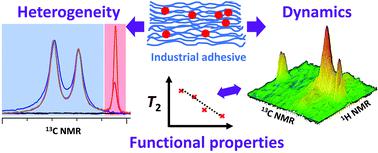当前位置:
X-MOL 学术
›
Polym. Chem.
›
论文详情
Our official English website, www.x-mol.net, welcomes your feedback! (Note: you will need to create a separate account there.)
Advanced spectroscopy, microscopy, diffraction and thermal analysis of polyamide adhesives and prediction of their functional properties with solid-state NMR spectroscopy
Polymer Chemistry ( IF 4.6 ) Pub Date : 2020-12-16 , DOI: 10.1039/d0py01348j Kash A. Bhullar 1, 2, 3, 4, 5 , Aaron Meinel 1, 2, 3, 4, 5 , Kennedy Maeder 1, 2, 3, 4, 5 , Richard Wuhrer 1, 4, 5, 6 , Marianne Gaborieau 1, 2, 3, 4, 5 , Patrice Castignolles 1, 2, 3, 4, 5
Polymer Chemistry ( IF 4.6 ) Pub Date : 2020-12-16 , DOI: 10.1039/d0py01348j Kash A. Bhullar 1, 2, 3, 4, 5 , Aaron Meinel 1, 2, 3, 4, 5 , Kennedy Maeder 1, 2, 3, 4, 5 , Richard Wuhrer 1, 4, 5, 6 , Marianne Gaborieau 1, 2, 3, 4, 5 , Patrice Castignolles 1, 2, 3, 4, 5
Affiliation

|
Adhesives are an essential class of industrial polymers with applications ranging from pressure-sensitive adhesives to hot-melt adhesives used for repairing conveyor belts in mines. The composition and homogeneity of a polyamide-based hot-melt adhesive (HMA) was revealed with attenuated total reflection (ATR)-FTIR and solid-state NMR spectroscopy. Analysis of the polyamide shows that it is obtained through sustainable manufacturing based on dimer acids. ATR-FTIR showed incorporation of an abrasion-resistant additive on the surface of the HMA but was unsuitable for other additives such as carbon black or an antistatic agent. Quantitative 13C NMR spectroscopy revealed heterogeneity in the distribution of an antistatic agent in the HMA, which was supported by observations with differential scanning calorimetry (DSC). 1H NMR relaxation and two-dimensional wideline separation (2D-WISE) NMR revealed differences in the molecular dynamics of functional groups in the polyamide resin and the additives dispersed in the resin matrix. 1H T2 relaxation revealed that the molecular mobility of the least mobile and moderately mobile components increased with increasing temperature and antistatic agent content. 2D-WISE NMR revealed a phase separation in the base resin matrix and plasticization of the whole sample at very high antistatic agent content. 1H T2 relaxation showed possible correlations with mechanical properties such as Young's modulus and Shore A hardness and weaker correlations with adhesive properties such as T-peel strength. This shows the suitability of NMR to assist product innovation through the design of better-performing HMAs or of HMAs for application in different climatic conditions.
中文翻译:

聚酰胺胶粘剂的高级光谱,显微镜,衍射和热分析以及固态NMR光谱对其功能性质的预测
胶粘剂是工业聚合物中必不可少的一类,其应用范围从压敏胶粘剂到用于修复矿井输送带的热熔胶粘剂。通过衰减全反射(ATR)-FTIR和固态NMR光谱揭示了聚酰胺基热熔胶(HMA)的组成和均匀性。对聚酰胺的分析表明,它是通过基于二聚酸的可持续生产而获得的。ATR-FTIR显示在HMA的表面上加入了耐磨添加剂,但不适用于其他添加剂,例如炭黑或抗静电剂。定量13C NMR光谱显示HMA中抗静电剂的分布不均匀,这通过差示扫描量热法(DSC)的观察得到支持。1 H NMR弛豫和二维宽线分离(2D-WISE)NMR揭示了聚酰胺树脂中官能团的分子动力学和分散在树脂基体中的添加剂的分子动力学差异。1 H T 2弛豫表明,最不活动和中度活动的组分的分子迁移率随温度和抗静电剂含量的增加而增加。2D-WISE NMR显示,在非常高的抗静电剂含量下,基础树脂基质中发生了相分离,并使整个样品发生了增塑。1 ħ Ť2松弛显示出与机械性能如杨氏模量和肖氏A硬度的可能相关性,以及与粘合性能如T剥离强度的较弱的相关性。这表明NMR通过设计性能更好的HMA或设计用于不同气候条件的HMA来辅助产品创新的适用性。
更新日期:2020-12-24
中文翻译:

聚酰胺胶粘剂的高级光谱,显微镜,衍射和热分析以及固态NMR光谱对其功能性质的预测
胶粘剂是工业聚合物中必不可少的一类,其应用范围从压敏胶粘剂到用于修复矿井输送带的热熔胶粘剂。通过衰减全反射(ATR)-FTIR和固态NMR光谱揭示了聚酰胺基热熔胶(HMA)的组成和均匀性。对聚酰胺的分析表明,它是通过基于二聚酸的可持续生产而获得的。ATR-FTIR显示在HMA的表面上加入了耐磨添加剂,但不适用于其他添加剂,例如炭黑或抗静电剂。定量13C NMR光谱显示HMA中抗静电剂的分布不均匀,这通过差示扫描量热法(DSC)的观察得到支持。1 H NMR弛豫和二维宽线分离(2D-WISE)NMR揭示了聚酰胺树脂中官能团的分子动力学和分散在树脂基体中的添加剂的分子动力学差异。1 H T 2弛豫表明,最不活动和中度活动的组分的分子迁移率随温度和抗静电剂含量的增加而增加。2D-WISE NMR显示,在非常高的抗静电剂含量下,基础树脂基质中发生了相分离,并使整个样品发生了增塑。1 ħ Ť2松弛显示出与机械性能如杨氏模量和肖氏A硬度的可能相关性,以及与粘合性能如T剥离强度的较弱的相关性。这表明NMR通过设计性能更好的HMA或设计用于不同气候条件的HMA来辅助产品创新的适用性。


























 京公网安备 11010802027423号
京公网安备 11010802027423号